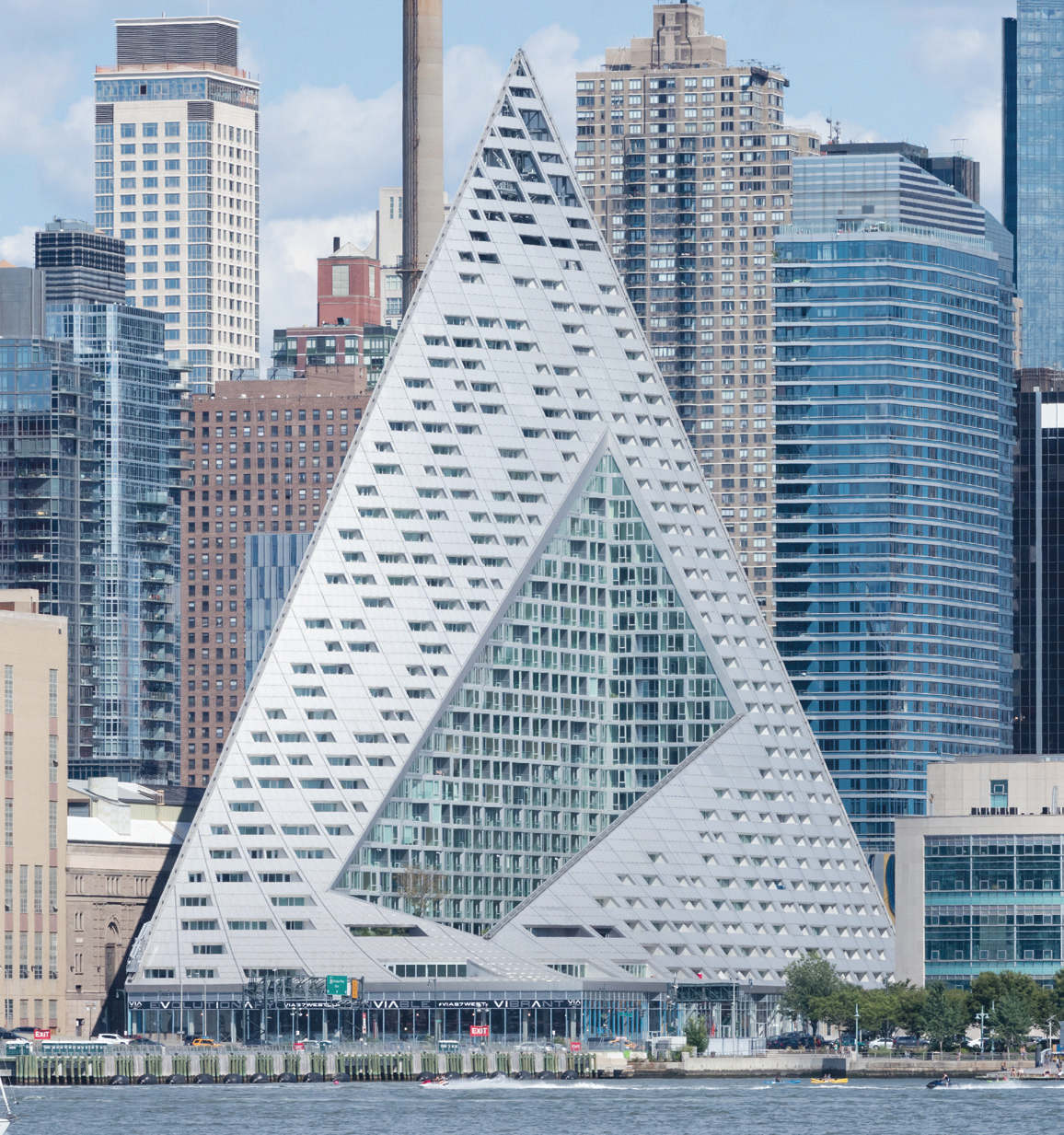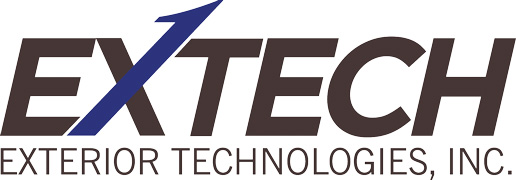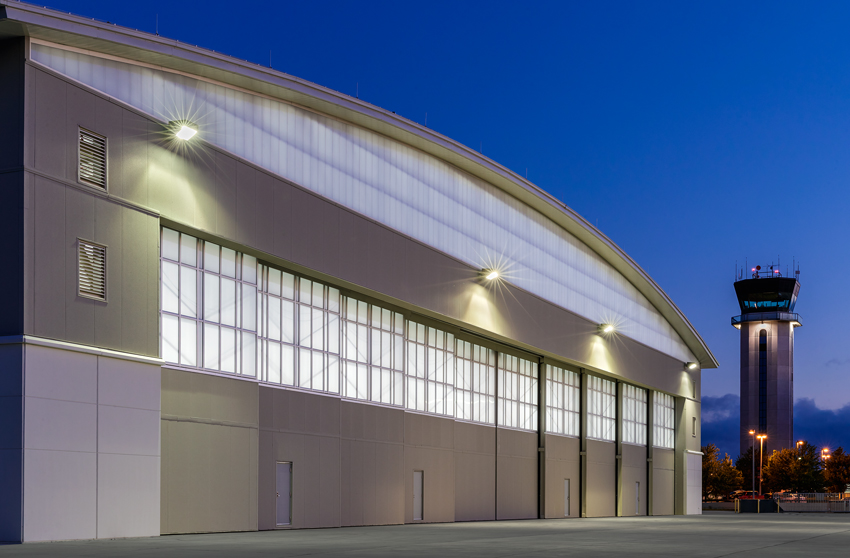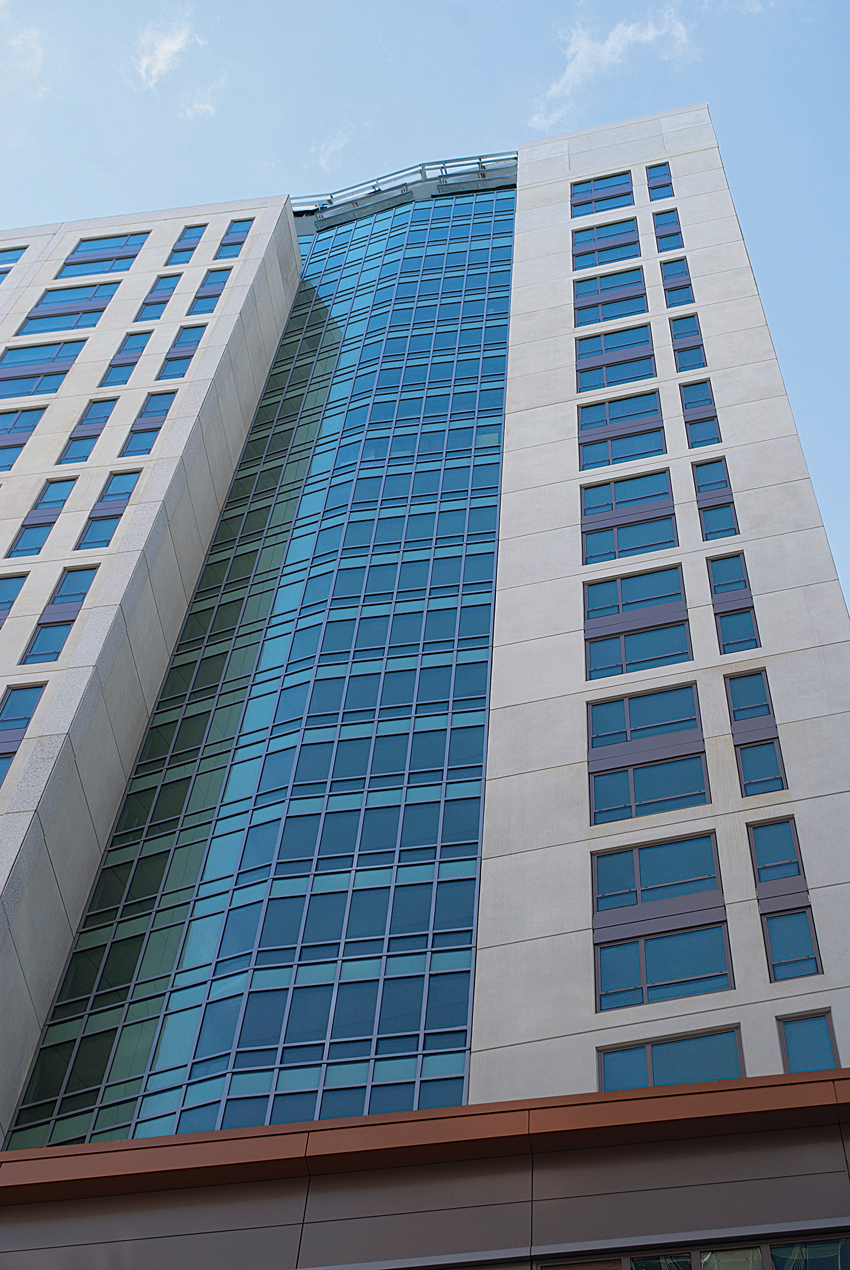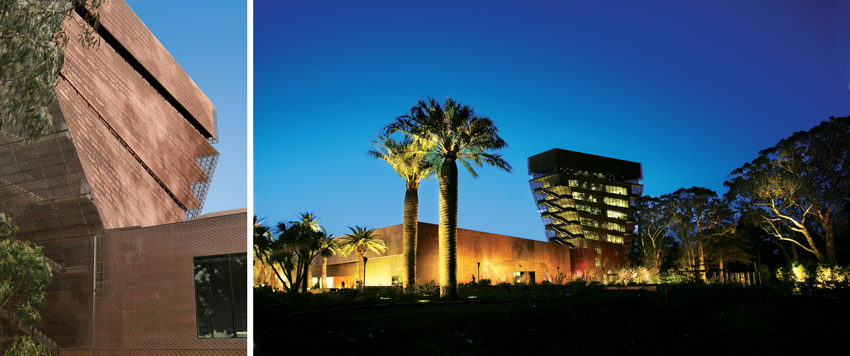This CE Center article is no longer eligible for receiving credits.
Architectural Louvers in Facades
Buildings require a precise means to provide intake for outside air as well as exhaust for HVAC systems. Some building designs are also allowing the facade to provide natural ventilation so the building can “breathe” or vent. While the size and locations of such intake or exhaust openings are determined in concert with mechanical engineers, it is typically the architect who determines the aesthetics and how the louvers integrate with the facade. Commonly, the solution lies in selecting architectural louvers which allow for proper airflow while preventing water and even wind-driven rain from entering, plus providing frame joinery that is integral to the adjacent facade. Fortunately, architectural louvers, like expansion joint covers, can be designed to meet these performance needs and be readily customized to integrate into virtually any building facade.
Architectural louvers are typically designed and engineered to meet some specific and demanding performance requirements. Louvers are available in a range of performance categories, including storm-resistant, extreme-weather resistant, impact-rated, acoustically rated, drainable, non-drainable, operating, and even blast-resistant selections. But it’s not enough to just pick from one of these different louver types when specifying them. The louver system also needs to be independently tested and certified by the Air Movement and Control Association (AMCA). This is the third-party testing agency for the louver industry that provides a means for manufacturers and products to have consistent and accurate published performance data. No louver model should be used without the appropriate AMCA seal located on the manufacturer’s technical data sheet. In particular, AMCA Publication 511 dictates the proper presentation of data and other required technical procedures for certification of air control devices under the AMCA Certified Ratings Program. ANSI/AMCA Standard 500-L1 is the basis of this program and outlines the testing protocols of louvers. Its goal is not to establish minimum/maximum performance ratings but rather to outline a standardized method for testing louvers for different parameters. It includes a laboratory method of testing louvers for ratings in the categories of Air Performance, Point of Beginning Water Penetration, and Wind Driven Rain. In addition, Free Area is included as a calculation, rather than a test, but is also a crucial performance indicator.
Clearly the balance of performance and aesthetics of the louvers is important so they meet the needs of particular buildings, but anytime they are visible on the facade, their ability to blend in or enhance a building design scheme is important too. Aesthetically, architectural louvers offer considerable design flexibility. Louvers can be installed and oriented either horizontally or vertically. They can be custom-curved, outfitted with creative blade color patterns, use varying blade depths, or include asymmetrical blade frequencies and staggered blade placement. LED lights can even be added to create a dramatic or subdued accent. Louvers can be selected and specified in a range of profile styles with different appearances across the louver blade areas. Many are available with a full palette of color options, including color shifting, wood grain, and faux stone finishes. There is even at least one product that offers a louver hidden by perforated sheet, thereby allowing all the air movement, security, and sight screening of standard louvers but with a fresh, modern appearance.
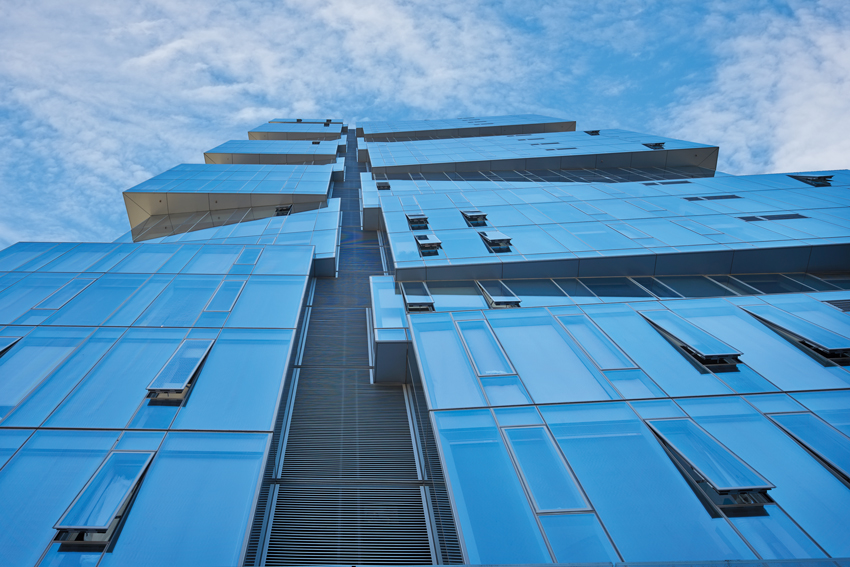
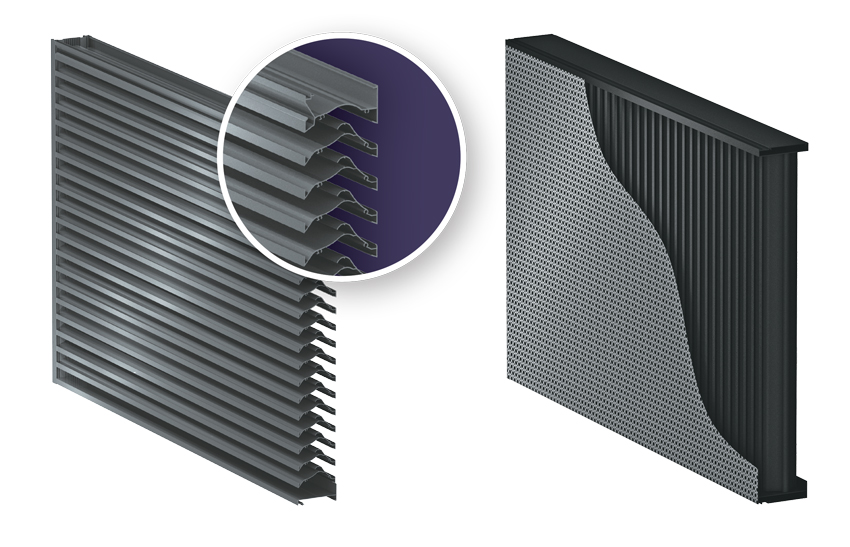
Images courtesy of Construction Specialties
Different types of louvers are available for facades to suit different performance requirements and to provide different design appearances.
In addition to the louver blades, it is increasingly important for the louver frames to have custom joinery to allow for integration into the adjacent facade system. This allows for consistent envelope performance and consistent framing sightlines. They can be specified in colors or other details to match or complement the louver blades or the surrounding facade material. In this way, louver systems can integrate into metal panel, storefront, or curtain wall along with a variety of other facade systems. Perimeter frame extrusions can be standard or custom created to achieve the desired look while not compromising performance.
While some architectural louver products are standard “off-the-shelf” systems, custom systems are becoming more common too. Architectural louvers are often designed to have custom joinery to integrate into curtain wall and metal panel facade systems for example. And they are available with additional customized accessories such as bird screens, sealed insulated blank off panels, sill pans, and LED lights. Often, a custom application can benefit from working with a manufacturer who can run custom tests in certified test chambers on site. Such testing should address air performance, water penetration, and wind-driven rain penetration of the louver but also test to ensure that the integrity and performance of the curtain wall/louver joinery. It is through this approach to custom designs and applications that architectural louvers can help elevate both the look and performance of the building facade.
Eric Sposito, CDT, is the general sales manager at Construction Specialties, a manufacturer of a wide range of architectural louvers. He says that “Custom-designed architectural louvers allow architects to defy traditional airflow design conventions in order to achieve their true vision, without sacrificing performance.” In that regard, they can readily meet all design and performance criteria.
Conclusion
Building facades provide a wealth of design opportunities with a wide range of materials and systems to choose from. They also require careful attention to details to be sure that all of the performance needs are met to control wind, water, sun, heat, and normal movement due to expansion and contraction. By keeping up to date with manufactured products, innovations, and creative applications, architects can design buildings that are vibrant, exciting, and long lasting.
Peter J. Arsenault, FAIA, NCARB, LEED-AP is a practicing architect, a green building consultant, continuing education presenter, and a prolific author engaged nationwide in advancing building performance through better design. www.linkedin.com/in/pjaarch
Building facades are the most publicly visible design aspect of a building and at the same time they are most vulnerable to performance issues. They need to enclose the building and control the flow of heat, light, air, and water, but they also need to look good doing it—typically for a long time. When they are well-designed and constructed properly, they can meet these needs by providing stunning exteriors that allow light and ventilation into interior spaces creating delightful places to live, work, or play. At the same time, well-designed facades can perform with long-lasting durability that meets or exceeds a variety of code requirements related to structural integrity, weather resistance, seismic forces, energy efficiency, and fire ratings. However, when done poorly, facades may deteriorate slowly until their original beauty degrades and performance declines noticeably to the point of needing replacement. Given this broad significance of facades, it is not surprising that they are the focus of considerable design efforts, fastidious construction methods, and sophisticated manufacturing techniques. In this continuing education course, we cover some of the latest materials and products that are available to help create distinctive and attractive building facades that can perform as well as they look.
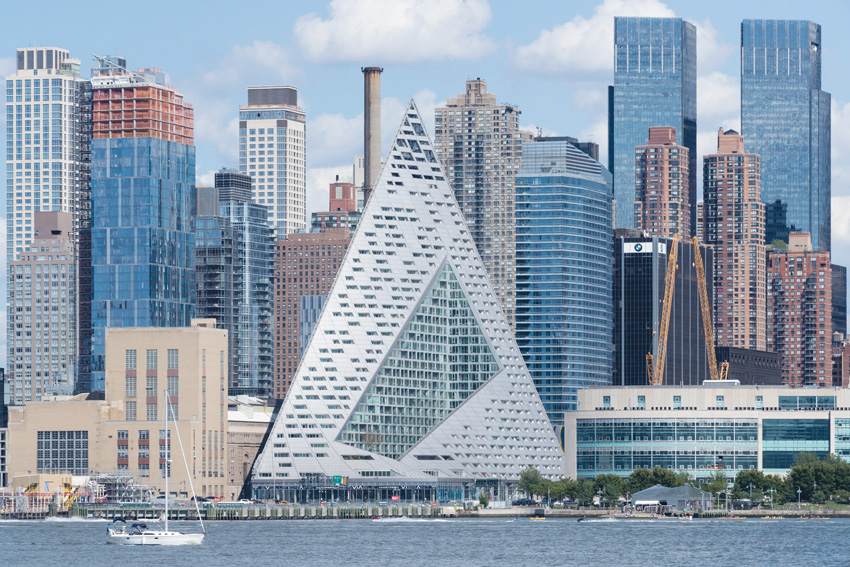
Photo courtesy of Construction Specialties
Building facades provide the visible exterior design of a building but need to perform as the barrier between indoors and outdoors while allowing light and ventilation to penetrate in a controlled manner.
Daylighting Facades
The use of natural daylighting in buildings has always been a desirable trait in building facades, and in recent times it has become the focus of designs that seek energy efficiency and good interior light quality. This focus has led to increased consideration of other glazing choices besides glass. Cellular polycarbonate glazing has emerged as one of the preferred materials for daylighting in many buildings due to its durability, glare reduction capabilities, occupant comfort benefits, and sustainability. Polycarbonate is lightweight and clear enough to transmit light while possessing the strength to withstand hurricane-force winds and blown debris. It isn’t affected by yellowing or “fiber-bloom,” as is common in fiberglass reinforced panel (FRP) glazing. Because of these traits, plus its fire-resistance rating capability, higher insulating potential, recyclability, and its ability to be shaped and formed, polycarbonate has been used in a wide range of buildings, from industrial structures that demand resilience to cultural institutions that prefer softer, more refined aesthetics.
From a practical standpoint, new advancements in manufacturing technology have further enhanced the benefits of polycarbonate glazing including the following:
- Ultraviolet (UV) Light Resistance and Blocking: New coating technology has been developed to resist the damaging effects of UV light such that polycarbonate panel manufacturers now offer 10-year weatherability warranties. The ability of the glazing to further block the transmission of UV light waves into the building means that interior finishes are protected from accelerated fading.
- Anti-Reflective: In cases where the reduction of exterior reflective glare is needed for a building’s design, anti-reflective polycarbonate glazing is available. Such systems facilitate a better distribution of light throughout a building’s interior while reducing reflections and glare. This option is also ideal for entertainment venues that want to project high-resolution images and lighting effects onto a translucent backdrop.
- Infrared (IR) blocking: When providing high daylighting levels and solar thermal control are equally important, polycarbonate glazing is available with an external surface that filters unwanted infrared radiation to reduce the solar heat gain of a building. Thus, it promotes comfortable interior temperatures, reduces demand on the HVAC system, and saves on energy costs.
- Anti-Graffiti Surface: When a project is in a high-traffic area and is at risk of damage or vandalism, polycarbonate glazing can be specified with an anti-graffiti surface that resists vandalism and scratching. Anti-graffiti glazing is also resistant to natural weathering and typical chemicals, and it is easier to clean.
Of course, a robust daylighting facade system is not dependent on the glazing alone—it must also possess superior framing to withstand water and air infiltration and deliver long-lasting value. In this regard, there are several things to look for in a coordinated, manufactured system. The first is deep glazing channels. Since polycarbonate has a high coefficient of thermal expansion, normal glazing channels (like those used with glass-glazed systems) can lead to panel disengagement. When disengaged, the glazing comes loose from the framing, causing air and water leakage, and compromising the structural integrity of the glazing. To prevent this, deep glazing channels are necessary. Second is the use of low-friction gaskets. Daylighting systems require gaskets with low-friction surfaces which are securely glued in place. If gaskets are not glued into well-designed gasket tracks, and if they do not have low-friction surfaces, then they will become disengaged over time. Further, they will create noise as the glazing expands and contracts. Third is a panel setting seat for the glazing panel to sit on. These are necessary to keep the glazing panels from falling to the bottom of the sill profile, making them vulnerable to water penetration, interior condensation, and decay. Further, these seats must be designed so as to allow air to enter the cavities in the cellular polycarbonate. Some manufacturers don’t recognize the importance of these features, but they are essential for robust system performance.
It is also possible to specify and work with pre-fabricated systems as the best way to ensure quality control and avoid installation delays. Not all daylighting manufacturers offer this option, instead relying on field installers to cut, fit, and secure all of the parts and pieces together on the project site. In the interest of better quality control, systems created in controlled factory conditions are available in several types. Some, for example, offer beauty, durability, and economy with vertical panels up to 54 feet long, eliminating horizontal joints and leak potential. Employing tongue and groove joinery, they create a clean, unbroken appearance with an insulation value of up to R-5 for 50mm-thick panels. Other translucent wall systems can deliver daylighting in long spans with minimal structural support using an interlocking clamping structural mullion designed for high wind load and long span conditions. This approach provides a continuous wall of daylight that replicates the external appearance of a channel glass system but at a fraction of the cost. There is even a curtain wall system that can properly accept glass polycarbonate, and metal panels in the same system. All of these polycarbonate systems use deep glazing channels, low-friction gasketing, and controlled gasket to pressure deliver superior resistance to air and water infiltration as tested by AAMA criteria.
Bill Voegele is the president and founder of EXTECH/Exterior Technologies, Inc. He has seen, firsthand, the growth of daylighting in buildings in recent years. He observes, “Daylighting has become popular for good reason—it works. Several studies have proven that people are healthier, happier, and more productive when they work in naturally lighted environments.” Regarding the use of cellular polycarbonate, he reflects on the role the industry is playing. “Cellular polycarbonate systems are probably the most economical way to incorporate massive daylighting while still addressing all of the questions that arise regarding spanability, weatherability, light diffusion, and, in some cases, solar heat gain and glare reduction.” It is clear this material is poised for use in many more buildings going forward.
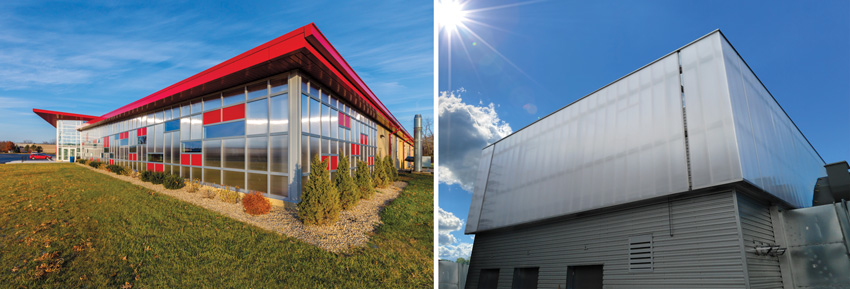
Photos courtesy of EXTECH/Exterior Technologies, Inc.
Cellular polycarbonate translucent glazing can provided daylighting facades for a variety of building types, including an integrated facade at Otterbein University (left) and Metro Tower III (right) which emulates the look of a frameless channel glass wall.
Steel Facades
Opaque portions of facades are needed in addition to the portions that allow in daylight, and often the question arises as to what material should be used to skin or clad those opaque areas. Here, there are seemingly limitless approaches with different products used to articulately detail facades in innovative ways that can transform buildings. While there are numerous choices, one that is being looked at creatively is the use of pre-finished steel panels.
Steel is one of the most commonly used materials for a structural system in buildings. A variety of components such as wide-flange beams, tube steel columns, and steel angles are prevalent in design and construction. Steel joists, roof, and floor deck round out a comprehensive structural steel package. Going beyond the constituent elements, a system-based approach helps to maximize efficiency. When all of the elements work together, the structural system meets engineering, economical, and aesthetic requirements. This holistic design strategy creates designs that are more cost-efficient since they use less material and, summarily, less waste. But those systems need to be coordinated with the design of the facade too, particularly since it is common for current building designs to take advantage of more integrated structural-steel systems. This approach moves beyond the practice of simply specifying individual steel elements and instead allows architects to engage more engineered, holistic ways to achieve cost, performance, and aesthetic goals.
Consistent with this approach, architects and building owners have begun to investigate and create some novel cladding and canopy solutions. One of the ways to do this is by using structural-steel decking (i.e., found in specification Division 5) for facade cladding in lieu of the typically more expensive architectural metals (i.e., found in specification Division 7). Such structural-steel decking is engineered for strength and durability and comes in a variety of profile shapes and depths that are often exposed to the interior as an exposed ceiling in many steel buildings. The attachment and field installation processes are well known and can produce a consistent, controlled performance related to loading conditions. Further, the appearance can hold up well over time. It should not be a surprise, then, to realize that this steel decking is being used not only for the underside of horizontal canopies on building exteriors, but also for vertical facades.
Standard profile deck along with long span deck can be readily installed vertically, minimizing joint lines and creating an attractive exterior cladding. The engineered corrugations in the decking can be sized to hold up against wind, weather, and usage as appropriate to the project location—making it suitable for a permanent or sacrificial skin or a rain screen on a facade. The same material can serve as a sun screen or solar shading device where appropriate. Steel deck is typically galvanized, and there are even options for variations like using stainless steel. Coatings can also be introduced to contribute to the durability of the material and longevity of the facade.
Recognizing the suitability of steel deck in exposed exterior locations, manufacturers can offer a range of pre-finished options using a variety of coatings. The coating systems are as attractive as they are performative. These coatings can handle aggressive conditions like swimming pools with corrosive chlorine, saline environments, or areas of high humidity. They are also effective at handling extreme environments such as marine locations and full ultraviolet exposures. Even in these situations, the pre-finished coating systems can carry warranties and withstand chalk and fade over the years.
These pre-finished products also give architects a broader design palette allowing color, pattern, and texture to be selected to suit particular aesthetics. Regardless of the final look, these new pre-finished deck options eliminate on-site painting or finishing—thus saving time during the construction process. The pre-finishing also helps to assure a consistent and uniform appearance.
Regarding sustainability, pre-finished materials eliminate the need to paint on the job site. Applying coating systems in a controlled setting reduces the risk of exposure to volatile organic compounds (VOCs) on the project site. Durable, pre-finished solutions lead to longer service life and minimal maintenance; longer service life leads to favorable life-cycle assessments. Further, steel is one of the most recycled building products in construction.
Alex Therien, AIA, LEED AP, is the market development manager for New Millennium Building Systems and works with integrated steel decking and cladding. He points out, “These structural products and coating systems were developed to address a design team’s aesthetic goals meeting their necessary criteria. By effectively eliminating extraneous materials, this creative facade approach is helping designers achieve their vision without sacrificing aesthetics, performance, or budget.”
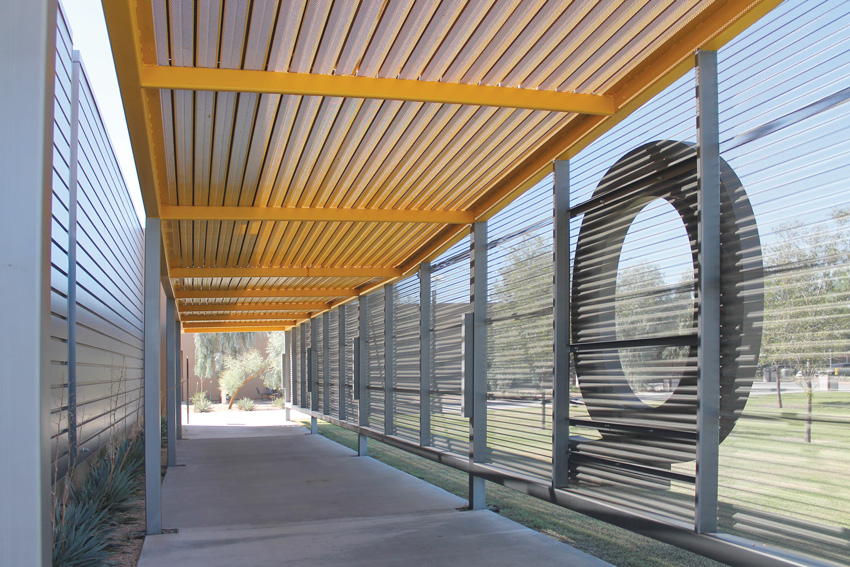
Photo courtesy of New Millennium Building Systems
Pre-finished or stainless-steel deck can be used for a variety of building exterior applications, including vertical facades, horizontal canopies, or sunscreens and shades.
Fire-Rated Curtain Wall Facades
A common means of creating a commercial building facade is to use a curtain wall system that spans vertically across multiple floors. Such systems provide a variety of options for appearance, glazing, and performance to suit a variety of building conditions. In some cases, the curtain wall is also required to meet fire rating requirements, usually because the building is close to or directly on the property line triggering the building code to dictate a minimum fire resistance in the interest of public safety. In that case, the entire curtain wall assembly must be shown to carry a fire-resistive rating as evidenced by independent testing and certification.
The type of products available that can meet this need are those that can show they comply with the requirements of ASTM E119 “Standard Test Methods for Fire Tests of Building Construction and Materials.” Following this standard, transparent barriers such as glazed curtain walls that use fire resistive glass and aluminum framing have demonstrated fire-resistive ratings of up to 120 minutes (2 hours). Because it is the whole system that needs to comply, not just any component, manufacturers of such systems are often involved directly with architects and other design professionals by providing a full array of technical services before, during and after a project. They may also be able to assist in code interpretation, product selection and design assistance all before a project is let for bid.
The primary function of fire-rated curtain wall systems is to enhance the safety of the building’s design and ultimately that of the building’s occupants in the event of a fire. However, they are also multi-functional in that they can be used to enhance the energy performance of the overall building envelope too. Such products are typically more robust than non-rated products and when combined with high-performance glass coatings, they can offer excellent overall U-Factors, Solar Heat Gain Coefficients (SHGC) and Visible Light Transmission (VLT). As a design resource in this regard, some glazing and framing products and systems can be researched as part of a program by the National Fenestration Rating Council (NFRC). This national organization provides the Component Modeling Approach (CMA) Software Tool (CMAST) for determining the predicted energy performance of fabricated fenestration of all types, including curtain walls. They also provide the CMAST Certified Products Directory (CMAST CPD) for Non-Residential Fenestration Energy Certification and Rating as a resource for designers to identify products that have been pre-tested and approved for stated energy-related performance characteristics.
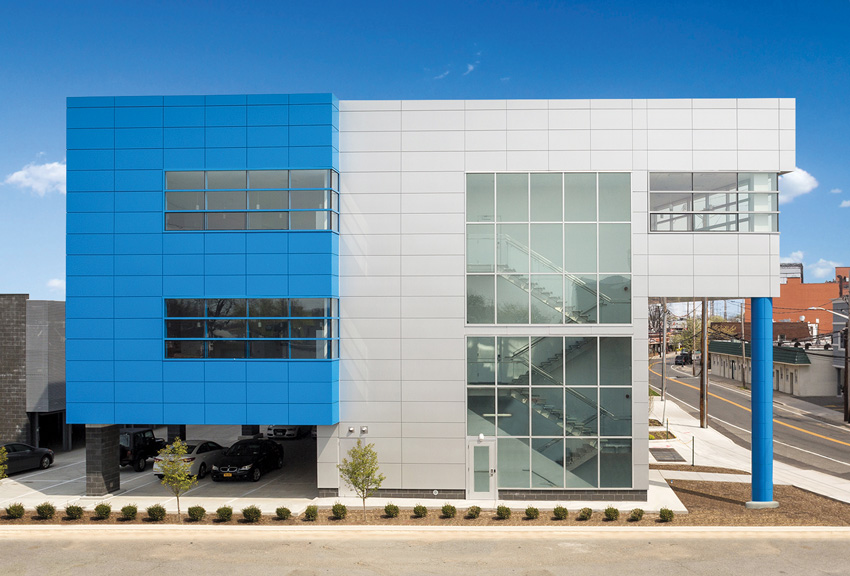
Photo courtesy of SAFTI FIRST Fire-Rated Glazing Solutions
At this private office building in New York, a 1-hour fire-resistive curtain wall system was used to bring natural light into the stairwell while creating a fire separation between the building and the adjacent parking lot.
The same attributes that make these curtain wall systems suitable for fire protection and energy efficiency also contribute to ready customization to include characteristics suitable for protection in other conditions too. This can include impacts from severe weather such as hurricanes or tornadoes, resistance to impact from projectiles or even bullets, and blast resistance where needed. In cases where sound attenuation is a concern, the glazing and the system can be designed to meet Sound Transmission Class (STC) or Outdoor Indoor Transmission Class (OITC) sound ratings. Overall, they can produce a well-rounded, code-compliant, high-performing fenestration and facade system.
From a design standpoint, architects do not have to choose between meeting design or performance requirements—they can have both. The fire-resistive curtain walls can mimic the appearance and performance of their non-rated counterparts and blend in seamlessly. As fire-resistive walls, it is worth noting that these products are appropriate for interior applications as well as exterior ones. They can enable architects to keep a consistent design intent and clear views while meeting fire-rated code requirements for interior or exterior conditions.
Tim Nass is vice president of national sales with SAFTI FIRST, a manufacturer of fire-rated glazing and curtain wall systems. He points out that “Architects will often inquire about ancillary performance levels like sound attenuation, U-Factor or Visible Light Transmission. They are often unaware that these products have been fabricated to match specifications for specific projects and are tested under dynamic conditions for total performance.” In that regard, the performance is less about looking things up on a table and more about working with a fabricator to achieve the performance levels desired. From an appearance standpoint, Nass points out “These systems also have the ability to match the non-rated products to maintain a consistent aesthetic between the exterior and the interior.” In all, such systems are fully customizable to meet the needs of specific projects.
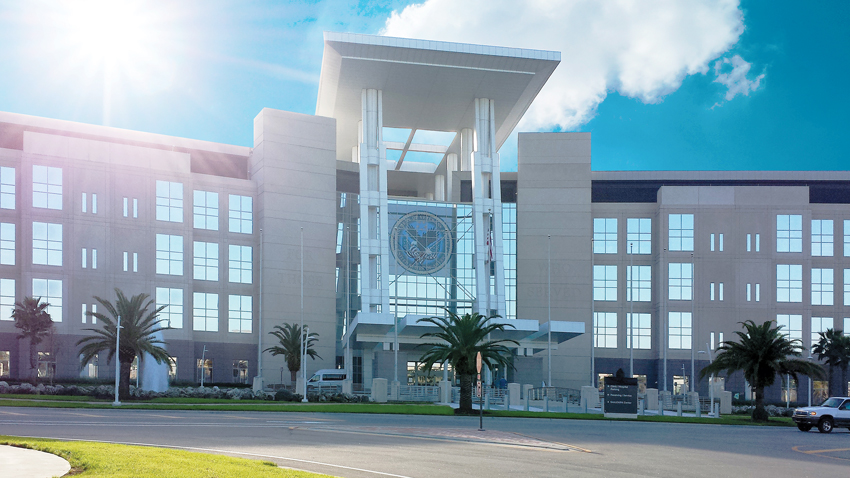
Photo courtesy of SAFTI FIRST Fire-Rated Glazing Solutions
At the VA Medical Center in Orlando, Florida, a 2-hour fire-resistive, hurricane-rated curtain wall that meets HVHZ (high velocity hurricane zone) testing requirements was incorporated into the design.
Facade Specialty Details
When it comes to facade design, the one thing that is certain is that there will be design and construction details to address. Those details can include connections, attachments, joints, or other conditions. Two things in particular deserve some attention here which are very common elements of many commercial building designs—expansion joints and architectural louvers in openings. Both of these elements can have a significant impact on the successful functioning of a facade in terms of the purpose they are intended to serve plus their integration with the surrounding facade materials. Additionally, they can have either a positive, negative, or neutral impact on the overall building design scheme depending on how they are handled. With the above in mind, let’s take a closer look at each of these specialty conditions.
Facade Expansion Joint Covers
Most commercial buildings of any size require expansion joints between sections of the structure to allow a building to expand, contract, or shift laterally due to imposed forces. Those movements can come from temperature changes causing materials to expand or contract, winds that move or sway the building, settlement over time, or seismic events. A well-designed series of expansion joints will allow sections of the building to move independently of each other without damaging either the structure or the finish materials.
Of course, leaving an expansion joint open to the elements on a facade is not a realistic solution. Hence, those joints need to be covered in a manner that maintains the integrity of the joint and the facade, both for appearance as well as performance, while still allowing for independent building movement on either side of the joints. Metal expansion joint covers are typically manufactured to allow for the anticipated building movement by using components that are designed to slide or otherwise pass by each other or adjacent building portions. The means to do that will vary by manufacturer and by type of expansion joint cover, and manufacturers typically provide a range of product offerings to suit different conditions. Selecting the proper one will help assure that the building and the facade are protected from damage when, or if, building movement occurs.
In addition to allowing for movement, these expansion joint covers also need to be able to insulate and protect the joint opening from outside elements. If water or moisture make their way into the joint opening, then the building could be susceptible to leaking, moisture damage, mold, or other deterioration which could cause failure. Therefore, metal covers with a water and vapor barrier installed behind the cover are common, as are fully watertight solutions that fit into a joint opening. Similarly, if airborne dust, dirt, or other objects get in behind the expansion joint cover, then it may not function properly since the anticipated movement or sliding of components could be impaired. Hence the expansion joint cover needs to seal against such penetration of foreign matter as well.
While the need for expansion joints and covers is clear, there is a design aspect that needs to be addressed. Often, the architect’s main design concern is focused on concealing expansion joint covers so as not to have a significant impact on the overall building facade design. Manufacturers have responded with multiple options for covers that can be infilled with whatever facade materials are specified for the rest of the building, thus creating a rather continuous appearance. The metal of the expansion joint cover itself can also be custom colored to match a building’s facade and become virtually undetectable.
When an expansion joint cover type is identified that meets the aesthetic criteria for a project, architects can then work with manufacturers to verify that the performance criteria is met. Some provide considerable technical assistance and, when applicable, they can conduct cycle testing on a joint cover to verify their performance. From that standpoint, architects should have confidence that the solution they specify will both perform well and blend into the overall facade design in a minimally invasive way.
Kevin Smith, PE, is the engineering manager at Construction Specialties and provides technical assistance to architects on a regular basis regarding expansion joint covers. He points out that “Many of our expansion joint covers have been reimagined over the years to accommodate architects’ demand for better integration with their designs. Each project that we work on is an opportunity for us to evaluate how to refine our solutions for better performance, resiliency, and concealment.” Clearly, then, there is an ongoing interest within the industry to accommodate project specific requirements that address all aspects of incorporating expansion joints successfully into a building facade.
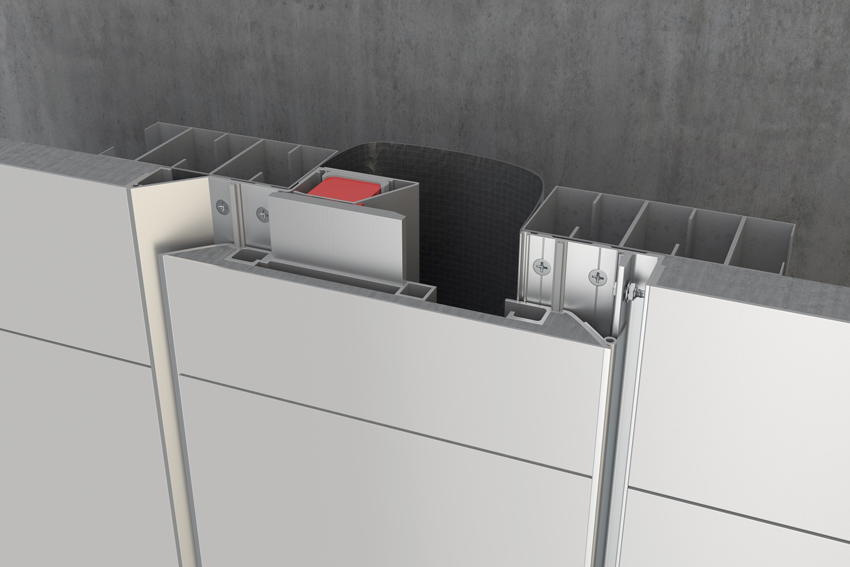
Images courtesy of Construction Specialties
Expansion joints in a building facade are often necessary but need to be protected with an expansion joint cover. Selecting the best product involves meeting the performance needs of a project but can also involve selecting one that allows matching facade material to be inserted in the face of cover to blend with the overall design.
Architectural Louvers in Facades
Buildings require a precise means to provide intake for outside air as well as exhaust for HVAC systems. Some building designs are also allowing the facade to provide natural ventilation so the building can “breathe” or vent. While the size and locations of such intake or exhaust openings are determined in concert with mechanical engineers, it is typically the architect who determines the aesthetics and how the louvers integrate with the facade. Commonly, the solution lies in selecting architectural louvers which allow for proper airflow while preventing water and even wind-driven rain from entering, plus providing frame joinery that is integral to the adjacent facade. Fortunately, architectural louvers, like expansion joint covers, can be designed to meet these performance needs and be readily customized to integrate into virtually any building facade.
Architectural louvers are typically designed and engineered to meet some specific and demanding performance requirements. Louvers are available in a range of performance categories, including storm-resistant, extreme-weather resistant, impact-rated, acoustically rated, drainable, non-drainable, operating, and even blast-resistant selections. But it’s not enough to just pick from one of these different louver types when specifying them. The louver system also needs to be independently tested and certified by the Air Movement and Control Association (AMCA). This is the third-party testing agency for the louver industry that provides a means for manufacturers and products to have consistent and accurate published performance data. No louver model should be used without the appropriate AMCA seal located on the manufacturer’s technical data sheet. In particular, AMCA Publication 511 dictates the proper presentation of data and other required technical procedures for certification of air control devices under the AMCA Certified Ratings Program. ANSI/AMCA Standard 500-L1 is the basis of this program and outlines the testing protocols of louvers. Its goal is not to establish minimum/maximum performance ratings but rather to outline a standardized method for testing louvers for different parameters. It includes a laboratory method of testing louvers for ratings in the categories of Air Performance, Point of Beginning Water Penetration, and Wind Driven Rain. In addition, Free Area is included as a calculation, rather than a test, but is also a crucial performance indicator.
Clearly the balance of performance and aesthetics of the louvers is important so they meet the needs of particular buildings, but anytime they are visible on the facade, their ability to blend in or enhance a building design scheme is important too. Aesthetically, architectural louvers offer considerable design flexibility. Louvers can be installed and oriented either horizontally or vertically. They can be custom-curved, outfitted with creative blade color patterns, use varying blade depths, or include asymmetrical blade frequencies and staggered blade placement. LED lights can even be added to create a dramatic or subdued accent. Louvers can be selected and specified in a range of profile styles with different appearances across the louver blade areas. Many are available with a full palette of color options, including color shifting, wood grain, and faux stone finishes. There is even at least one product that offers a louver hidden by perforated sheet, thereby allowing all the air movement, security, and sight screening of standard louvers but with a fresh, modern appearance.


Images courtesy of Construction Specialties
Different types of louvers are available for facades to suit different performance requirements and to provide different design appearances.
In addition to the louver blades, it is increasingly important for the louver frames to have custom joinery to allow for integration into the adjacent facade system. This allows for consistent envelope performance and consistent framing sightlines. They can be specified in colors or other details to match or complement the louver blades or the surrounding facade material. In this way, louver systems can integrate into metal panel, storefront, or curtain wall along with a variety of other facade systems. Perimeter frame extrusions can be standard or custom created to achieve the desired look while not compromising performance.
While some architectural louver products are standard “off-the-shelf” systems, custom systems are becoming more common too. Architectural louvers are often designed to have custom joinery to integrate into curtain wall and metal panel facade systems for example. And they are available with additional customized accessories such as bird screens, sealed insulated blank off panels, sill pans, and LED lights. Often, a custom application can benefit from working with a manufacturer who can run custom tests in certified test chambers on site. Such testing should address air performance, water penetration, and wind-driven rain penetration of the louver but also test to ensure that the integrity and performance of the curtain wall/louver joinery. It is through this approach to custom designs and applications that architectural louvers can help elevate both the look and performance of the building facade.
Eric Sposito, CDT, is the general sales manager at Construction Specialties, a manufacturer of a wide range of architectural louvers. He says that “Custom-designed architectural louvers allow architects to defy traditional airflow design conventions in order to achieve their true vision, without sacrificing performance.” In that regard, they can readily meet all design and performance criteria.
Conclusion
Building facades provide a wealth of design opportunities with a wide range of materials and systems to choose from. They also require careful attention to details to be sure that all of the performance needs are met to control wind, water, sun, heat, and normal movement due to expansion and contraction. By keeping up to date with manufactured products, innovations, and creative applications, architects can design buildings that are vibrant, exciting, and long lasting.
Peter J. Arsenault, FAIA, NCARB, LEED-AP is a practicing architect, a green building consultant, continuing education presenter, and a prolific author engaged nationwide in advancing building performance through better design. www.linkedin.com/in/pjaarch



